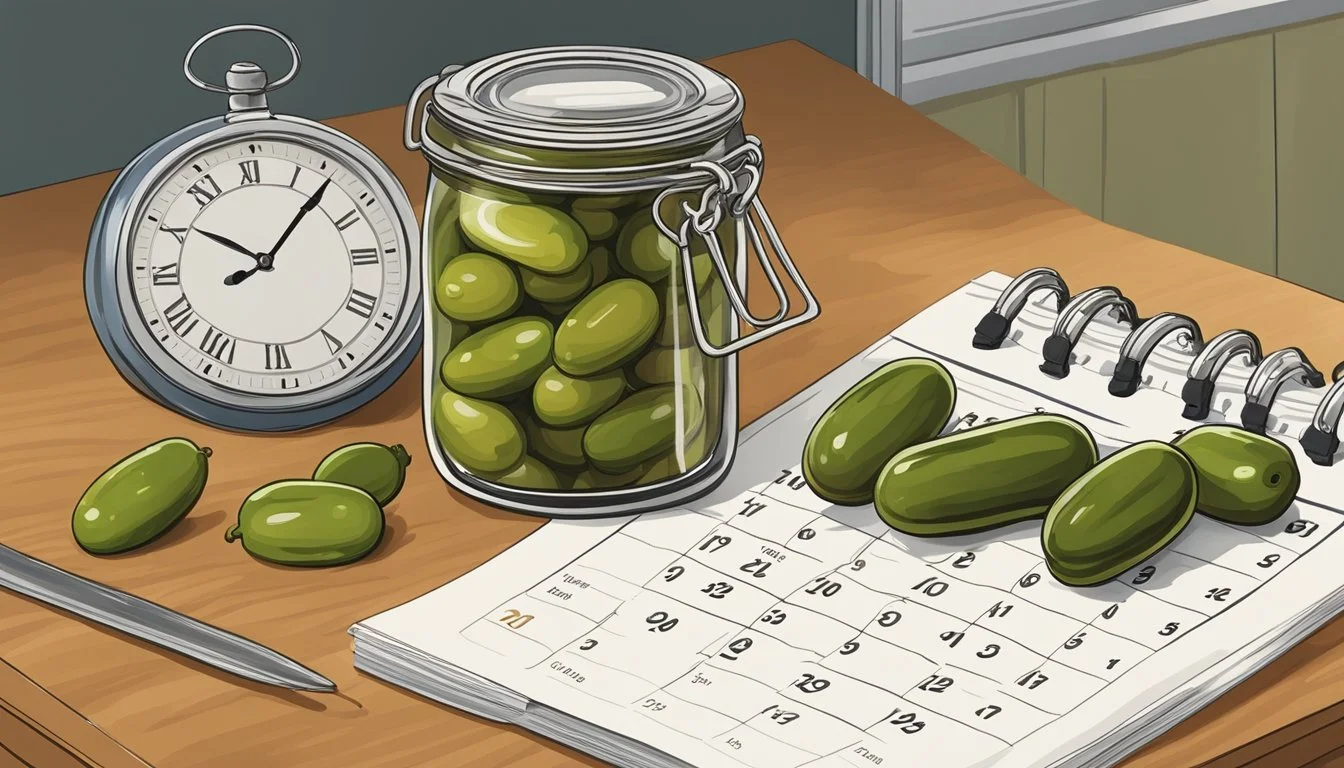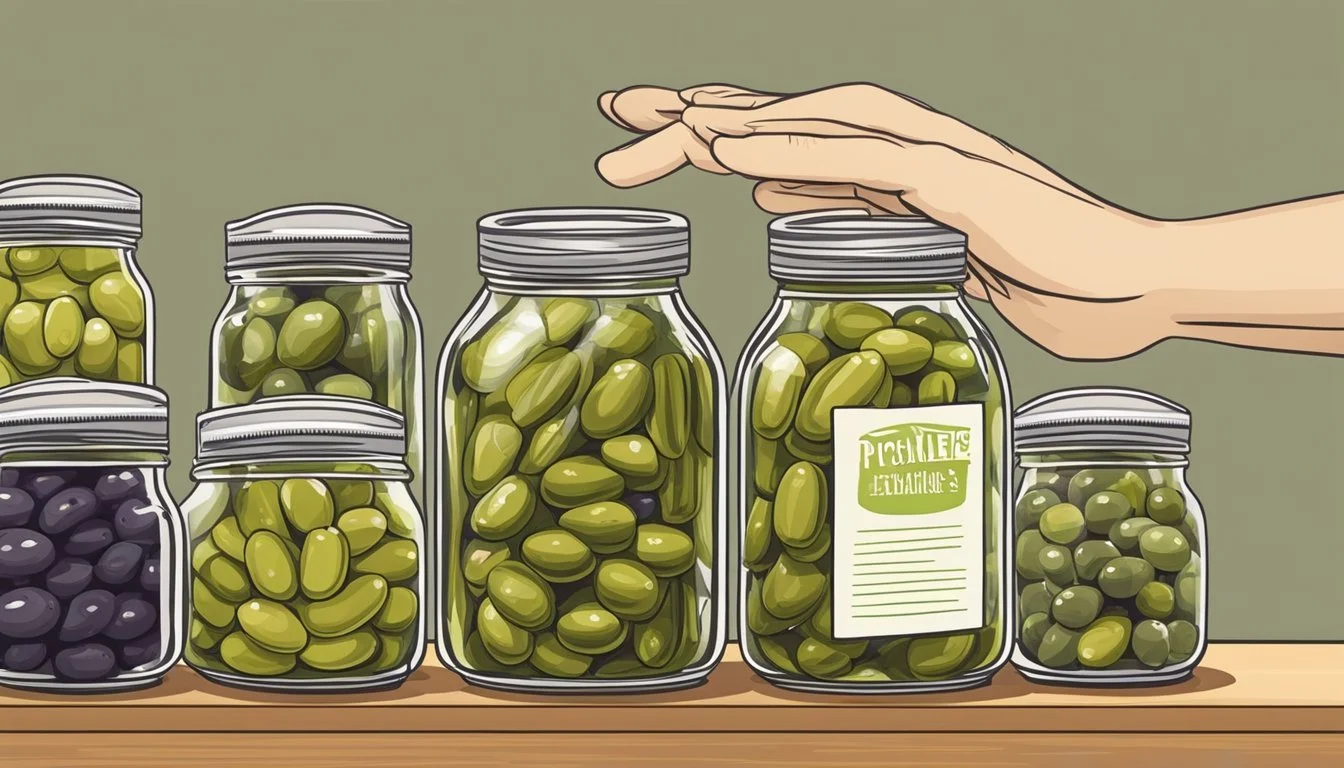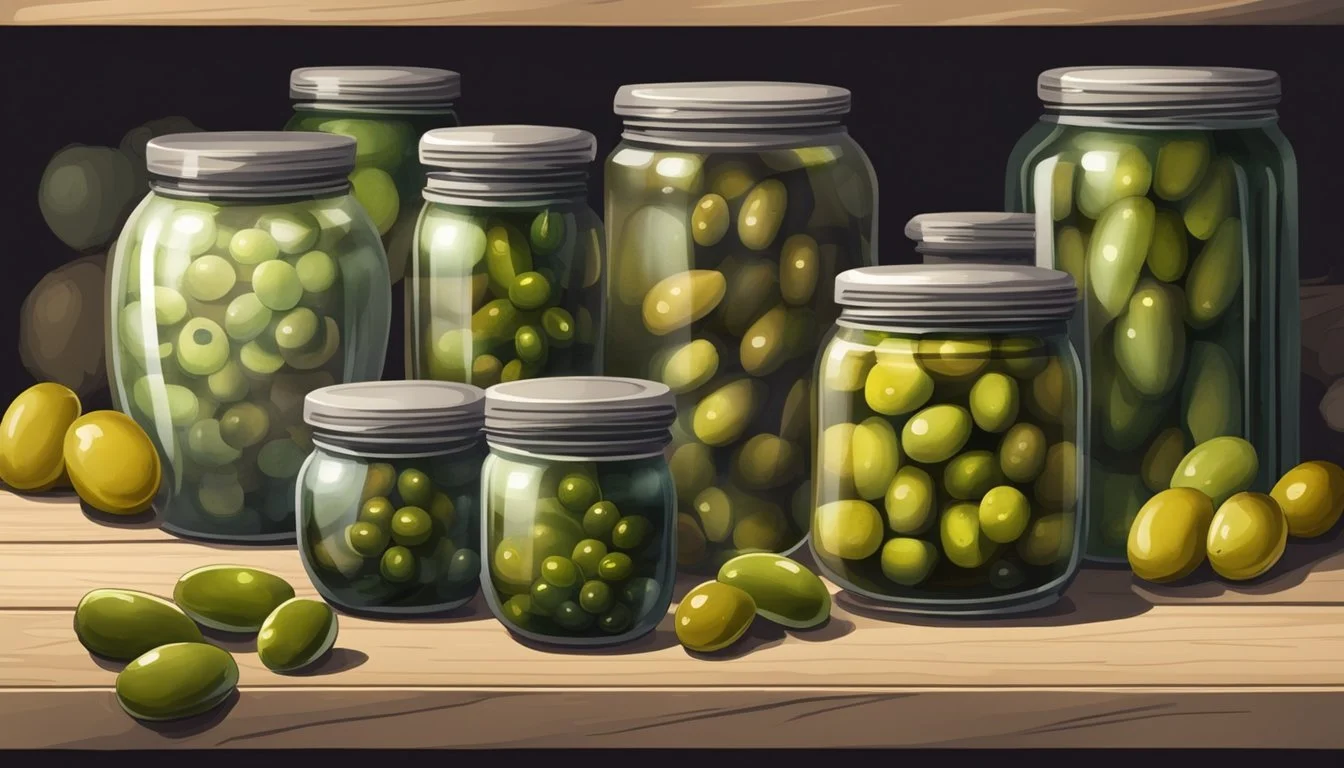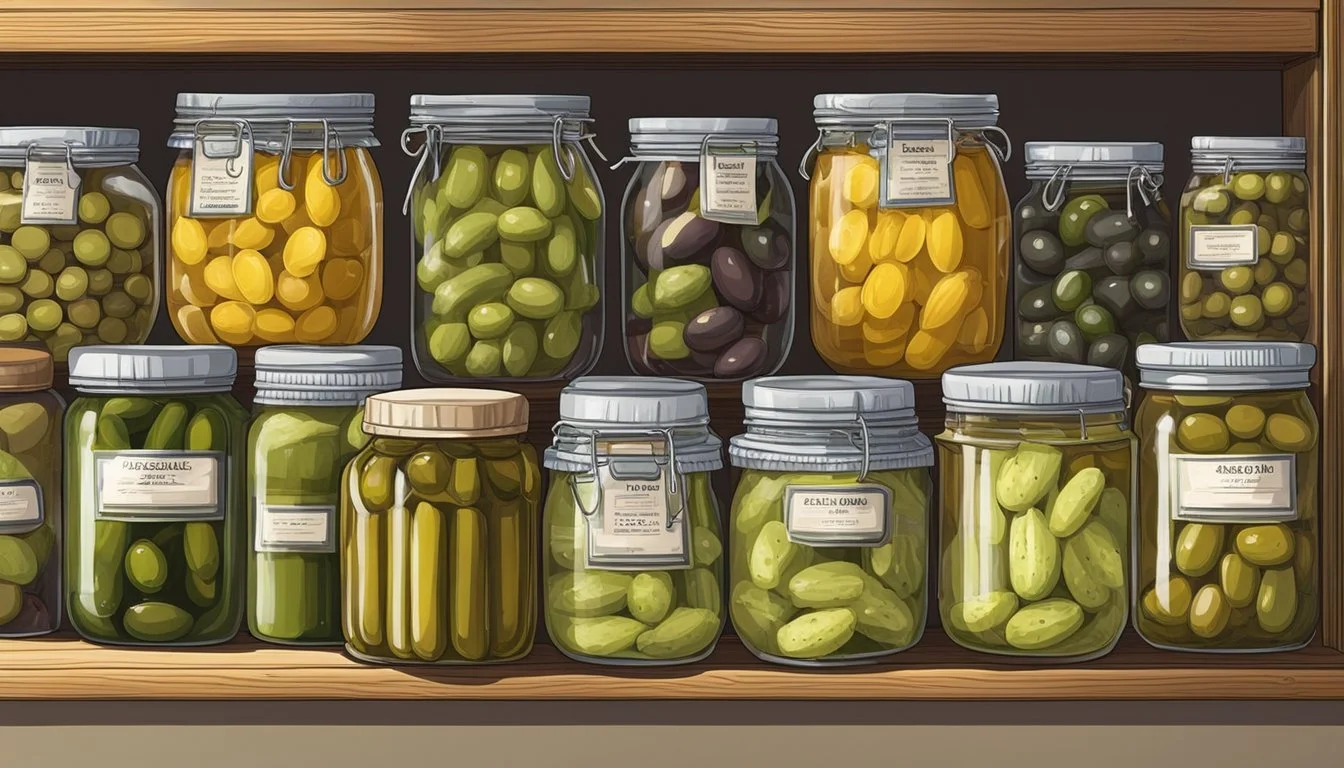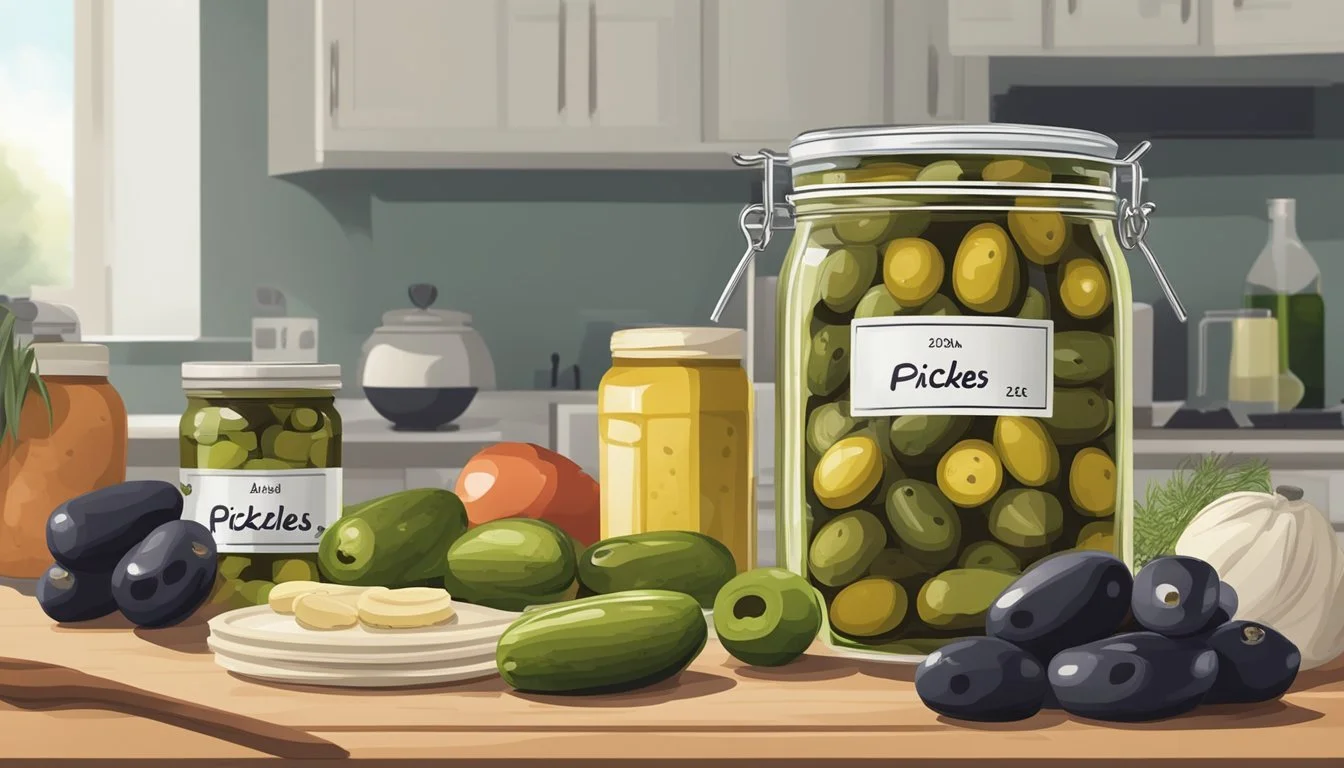How Long Do Pickles and Olives Last?
Shelf Life and Storage Tips
Pickles and olives (What wine goes well with olives?) are popular preserved foods enjoyed for their tangy and savory flavors. The shelf life of these items is influenced by various factors, including the method of preservation, storage conditions, and whether the container has been opened. Typically, pickles can remain safe and retain quality for 1 to 3 months in the refrigerator once opened. Olives exhibit a similar longevity, with unopened jars or cans capable of lasting up to two years when stored in a cool, dark place, and several months in the refrigerator after opening.
Proper storage is key to maintaining the freshness and safety of pickles and olives. It's important that they are kept in the refrigerator at or below 40°F to prevent the growth of harmful bacteria. For unopened cans or jars, a pantry or a cupboard away from heat and light sources can help preserve their quality until the expiration date or even beyond, provided the container remains sealed and undamaged.
It's essential for consumers to inspect the contents before consuming, checking for any signs of spoilage such as off odors, discoloration, or changes in texture. While these preserved foods are designed for long-term storage, they will eventually degrade, and consuming spoiled products can lead to foodborne illness.
Determining Freshness
When assessing the freshness of pickles and olives, one should pay close attention to their smell, appearance, texture, and taste. These sensory indicators are reliable measures to determine whether the product is still consumable.
By Smell and Appearance
A fresh pickle or olive should have a clean, acidic aroma characteristic of its pickling brine. The presence of a bad smell—foul, sour beyond the typical pickling scent, or reminiscent of decay—indicates spoilage. Visually, pickles and olives should retain their original color and should not show signs of mold or a cloudy brine, which can signify contamination or age.
Appearance Checklist:
Color: Vibrant, typical of the variety
Brine: Clear or slightly cloudy (olives can be more cloudy)
Mold: None should be present
By Texture and Taste
The texture of fresh pickles and olives should be firm, not mushy or overly soft. When biting into them, there should be a certain level of resistance and crispness. Flavor is also an important factor; they should taste as expected based on their type—sour, salty, or spiced. Any deviation such as a lack of flavor or an off-taste could be indicative of spoilage.
Texture and Taste Checklist:
Firmness: Should be consistent with fresh product
Flavor: Expected sourness or saltiness, without any off or unusual tastes
Storage Guidelines
When it comes to extending the shelf life of pickles and olives, proper storage is key. Both items have different expected lifespans depending on whether they are stored unopened or opened, and following specific guidelines can help preserve their freshness and flavor.
Unopened Pickles and Olives
Unopened pickles should be kept in a cool, dry area such as a pantry or cupboard, away from direct sunlight and sources of heat. When stored properly at room temperature, unopened pickles can maintain quality for up to 1-2 years.
Location: Pantry or cupboard
Temperature: Room temperature
Light: Away from direct sunlight
Duration: 1-2 years
For unopened olives, similar conditions apply. They can last for up to two years when the container, typically a glass jar or a plastic container, remains sealed, and the storage environment adheres to the proper standards.
Container: Glass jar or plastic container
Seal: Must be sealed properly
Location: Pantry or cupboard
Temperature: Room temperature
Light: Away from direct sunlight
Duration: Up to 2 years
Opened Pickles and Olives
Once the seal is broken, opened pickles should be stored in the refrigerator in their original liquid to maintain quality. They should be consumed within 1-3 months for the best quality. The jar should be sealed tightly after each use.
Container: Original glass jar with liquid
Temperature: Refrigerated, 40°F or below
Seal: Tightly after each use
Duration: 1-3 months
Opened olives, on the other hand, should also be kept in the refrigerator, ideally in a sealed container to avoid absorbing other flavors. Opened olives can last up to 18 months when refrigerated, but for optimal taste, they should ideally be consumed within the first 6 months.
Storage: Refrigerated
Temperature: Cool
Container: Sealed properly
Duration: Up to 18 months (best within 6 months)
Maintaining the proper storage conditions for pickles and olives will help to ensure they remain safe for consumption and retain their intended flavor profiles for as long as possible.
Shelf Life Information
Understanding the shelf life of pickles and olives is crucial for maintaining their taste and ensuring food safety. This section outlines the expected durations and influences on the longevity of these preserved items.
General Shelf Life
Pickles typically have a long shelf life due to their acidic environment, which discourages bacterial growth. An unopened jar of pickles can last for up to 1 to 2 years when stored in a pantry. After opening, they should be kept in the refrigerator and are best consumed within 3 to 4 weeks, although they can remain safe to eat for several months if the brine is still clear. On the other hand, olives, which also benefit from a high-acid brine, have a slightly different timeline. An unopened jar or can has a shelf life of approximately 1 to 2 years. Once opened and refrigerated, olives should be eaten within 1 to 2 weeks for optimal flavor, but they can maintain food safety for up to 1 to 2 months if they are kept in a sufficient brine.
Labels and expiration dates on packaging serve as a guide for the consumer to determine the peak quality of the product. A "best before" date often indicates when the product is expected to start diminishing in quality, not necessarily when it becomes unsafe to eat.
Factors Affecting Shelf Life
Several elements play a crucial role in both the shelf life and the staying power of pickles and olives. Storage conditions such as temperature impact their longevity significantly. Pickles and olives should be stored in a cool, dry place prior to opening and refrigerated immediately after opening to inhibit bacterial growth. The container's seal integrity also matters; a compromised seal can lead to spoilage. The quality and acidity of the brine are essential—the high salt and acid levels create a hostile environment for bacteria.
Food safety is imperative when considering the shelf life of any consumable item. Visibly inspecting the brine for cloudiness and ensuring there are no off-putting smells can prevent the consumption of spoiled products. With pickles, if the brine becomes murky or the pickles smell disagreeable, it is a good indication that they should be discarded.
To extend the shelf life and maintain safety, it is important to use clean utensils when handling pickles and olives to prevent contamination. Keeping the brine level high enough to cover the products at all times will also help preserve their quality and safety.
Refrigeration and Temperature Control
Proper refrigeration is vital for preserving the freshness and extending the shelf life of both pickles and olives. Once opened, these items should be stored in the refrigerator to maintain optimum quality and inhibit bacterial growth.
Pickles: Refrigerator pickles must be kept in a cold environment after the jar has been opened. The fridge temperature should ideally be maintained between 34° and 40°F. Opened jars of pickles can last for about three to four weeks when stored correctly in the refrigerator. An unopened jar, when kept in the pantry, remains good for about one year from the purchase date; transferring it to the fridge is not necessary but can extend freshness once opened.
Olives: Similar to pickles, olives last longer when refrigerated. An unopened jar or plastic container can be kept for up to 12 months in a pantry setting, but it’s best to store them in the refrigerator once opened. There, they can be expected to last up to six months. Again, ensure that the fridge temperature is below 40°F.
When storing either pickles or olives in the refrigerator, it is beneficial to keep them in their original brine. This helps maintain their taste and texture. Here's a quick guide to storage times:
Product Unopened Shelf Life Opened Shelf Life (Refrigerated) Pickles Up to 1 year 3-4 weeks Olives Up to 12 months Up to 6 months
It is important to always check for signs of spoilage, such as a murky brine or an off odor, before consuming refrigerated pickles or olives.
Opening and Re-Sealing
Once a jar of pickles or olives is opened, its shelf life may be influenced by how it is re-sealed and stored. Oxygen exposure and potential contaminants can hasten spoilage. Therefore, proper re-sealing is a key factor in extending the freshness of these preserved foods.
Pickles: After opening, they should be kept refrigerated in their original brine. Users should ensure the jar is tightly sealed each time it's returned to the refrigerator. This practice will maintain their quality for up to two years.
Olives: Similar to pickles, olives must be kept refrigerated and tightly sealed once opened. Doing so helps in retaining their flavor and texture. Olive jars should always be sealed with care to prevent air exposure.
Opened Item Storage Condition Expected Shelf Life Pickles Refrigerated & sealed Up to 2 years Olives Refrigerated & sealed 1-2 years
For both pickles and olives, proper opening techniques are important to maintain the integrity of the seal. One should avoid using sharp instruments that can damage the jar or the lid, as this may prevent airtight sealing when reclosed.
In summary, once opened, both pickles and olives require careful sealing and refrigeration to maximize their shelf life. By adhering to these storage principles, the preserved items will remain fresh and safe for consumption for a considerable duration.
Signs of Spoilage
When assessing the longevity of pickles and olives, one must be vigilant for signs of spoilage. These fermented foods can last quite a while, but they are not impervious to spoilage. Here's what to look for to ensure food safety:
Visual Indicators:
Mold: If there is visible mold growth on the surface of the pickles or olives or inside the jar, it is a clear sign of spoilage.
Discoloration: Any significant change in color can indicate deterioration.
Olfactory Signs:
Unpleasant odor: A sour or off smell that deviates from the vinegar or brine normally present is indicative of bacterial growth.
Textural Changes:
Texture: If pickles or olives become too soft or mushy, they may be past their prime.
Brine Appearance:
Brine clarity: A murky brine may suggest the presence of microorganisms that could lead to spoilage.
Health Risks: Consuming spoiled foods can lead to health risks, as bad bacteria could produce toxins.
Immediate Action:
Disposal: If any signs of spoilage are present, the safest course of action is to discard the entire jar, including the brine.
By keeping an eye out for these signs and understanding the potential health risks posed by bad bacteria in spoiled foods, consumers can make informed decisions about their food safety.
Proper Storage Techniques
Maintaining the freshness and extending the shelf life of pickles and olives largely depends on proper storage. The lifespan of these items is influenced by the conditions under which they are kept, with particular attention to temperature, exposure to air, and the composition of the brine or preserving liquid.
For Pickles
Pickles require an acidic brine to ensure preservation. When unopened, they can be stored at room temperature in a cool, dark place. Once opened, the proper storage involves keeping them refrigerated in their original brine. Consistent refrigeration at or below 40°F is crucial to maintain freshness.
Unopened Pickles: Store in a cool, dark place.
Opened Pickles: Refrigerate in original brine.
For Olives
Olives should be stored in an airtight container to protect them from oxidation, which can alter their salty brine and affect taste. For optimal preservation, olives are best stored submerged in olive oil or their own salty brine, away from light and heat.
Unopened Olives: Cool, dark place, away from heat and light.
Opened Olives: Keep in olive oil or brine, in a sealed container in the refrigerator.
Food Safety Concerns
When it comes to preserving food safety with pickles and olives, it's crucial to monitor them for signs of spoilage. These preserved items can harbor bad bacteria if not stored or handled properly, posing health risks. One must be vigilant in ensuring that the integrity of the container is uncompromised, and the contents are free from unusual odors, colors, or textures.
Pickles usually retain their quality for 1 to 3 months post-opening if kept refrigerated. Here are key points for maintaining their safety:
Store canned pickles correctly in the fridge.
Inspect the jar for damage prior to use.
Observe for changes in appearance or smell.
Likewise, olives should also be stored properly to prevent foodborne illnesses:
Keep opened jars refrigerated and consume within a few weeks.
Discard any olives if mold or a sour smell is detected.
Ensure the brine remains clear and free from cloudiness.
It is important to be aware that expiration dates are not absolute indicators of safety; they are better treated as guidelines. Consumers should always inspect pickles and olives before consumption. Any signs of spoilage or contamination indicate that the food should not be consumed. One should not taste test the item but should rather discard it to avoid potential health risks.
Extending Shelf Life
To ensure pickles and olives last as long as possible, one must consider freezing options and optimal storage conditions. Adherence to proper storage techniques can significantly prolong the edibility and quality of these preserved foods.
Freezing Options
Freezing pickles is not commonly recommended, as it can significantly alter their texture; however, olives can be frozen if they are properly sealed in an airtight container or freezer bag. To freeze olives, one should:
Rinse olives to remove brine.
Dry them thoroughly to prevent ice crystals from forming.
Place in a single layer on a tray to freeze individually.
Transfer the frozen olives into an airtight container or bag to prevent freezer burn and odor absorption.
Optimal Storage Conditions
Proper food storage is critical for maximizing the shelf life of pickles and olives. They should be stored in conditions that mitigate the risk of spoilage. Here are specific guidelines:
Temperature: Keep refrigerated at 40°F or below after opening.
Container: Ensure that the original jar or a similar airtight container is sealed properly to prevent exposure to air and contaminants.
Location: Store in a dark, cool place away from direct sunlight if unopened. Refrigerate after opening.
By following these specific storage instructions, one can extend the shelf life of pickles and olives, enjoying them for longer periods while maintaining freshness and quality.
Pickles and Olives in Cooking
Pickles bring a distinctive tanginess to a dish, often adding both flavor and texture. They are commonly used chopped in tartar sauces, relishes, and salad dressings, enhancing the overall taste with their acidity. One can find pickles as a crunchy element in various sandwiches and burgers, providing a contrast to the softness of bread and the savory taste of meats.
Olives, on the other hand, contribute a savory and sometimes bitter profile, depending on their preparation. They can be served whole, pitted, or sliced and are frequently paired with cheeses and wines as appetizers. In Mediterranean cuisine, olives are a staple, intensifying the flavors in pasta dishes, stews, and pizza.
In the preparation of pasta, both pickles and olives can be used, although olives are more traditionally included. A classic Puttanesca sauce is a prime example, where olives are essential in achieving the right balance of saltiness and depth.
Here is a quick rundown of how pickles and olives can be incorporated:
Pickles:
Diced for tartar sauce or relish
Sliced for sandwiches or burgers
Olives:
Whole or sliced in salads
Both pickles and olives serve as flavor enhancers and should be used thoughtfully to ensure they complement the primary ingredients without overpowering them. Chefs may also use the brine from pickles and olives to add a subtle undertone of acidity or salinity to their dishes, thereby building complexity in the flavor profile.
Understanding Product Labeling
When purchasing pickles and olives, consumers may notice various dates printed on the labels. These dates are indicators of quality rather than safety. Manufacturers provide a best before date to suggest when the product will be at its peak freshness and flavor. However, products like pickles and olives are typically preserved through brining or pickling, processes that greatly extend their shelf lives.
The expiration date is often confused with the best before date, though it's less commonly used for pickle and olive products. Expiration dates imply that the product should not be consumed after the stated date due to potential health risks. For these preserved items, safety is typically ensured far beyond the date indicated.
Labeling terminology can vary, but here are common terms found on product labels:
Sell by: Advises retailers when the product should be sold or removed from the shelf.
Best by/best before: Indicates when the product is expected to be at its best flavor and quality.
Expiration date/use by: Suggests the last date the product should be used for peak quality.
It is important to distinguish these terms clearly to make informed choices about food quality and potential waste reduction. Despite these dates, the preservative nature of the brine in pickles and olives often allows them to be safe for consumption well after the best before date—provided they are stored properly.


